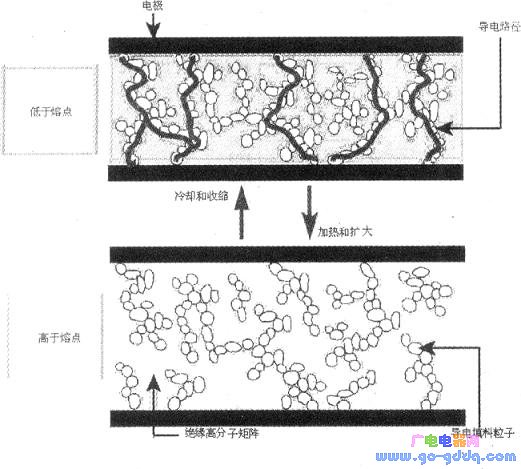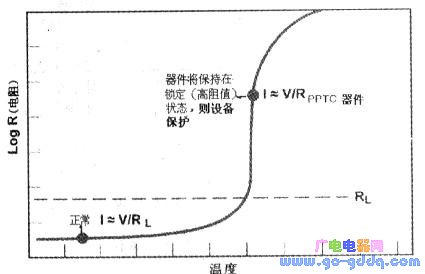The polymer positive temperature coefficient (PPTC) device is a conductive composite made of semi-crystalline polymer and conductive particles. Under normal operating temperatures, the conductive particles form a low-resistance conductive path within the polymer, as shown in the diagram below. However, when the temperature exceeds the switching temperature (TSE), the polymer's crystalline structure melts, transforming into an amorphous state. This can happen due to either an increase in ambient temperature or a surge in current through the device. As the material transitions from a crystalline to an amorphous state, its volume expands, causing the conductive particles to separate. This separation leads to a significant, non-linear rise in resistance, effectively limiting the current flow.

As illustrated in the figure, the resistance of the PPTC device typically increases by three or more orders of magnitude. This dramatic increase in resistance helps protect the connected equipment by reducing the fault current to a safe, steady-state level. The device remains in a high-impedance state until the fault is cleared and the power supply is disconnected. At that point, the conductive components cool down, recrystallize, and the PPTC returns to its low-resistance state, restoring normal operation of the circuit and the protected device.

The PolySwitch (self-recovery fuse) LVR device is specifically designed to protect both primary and secondary circuits in linear transformers. Utilizing proven self-recovering fuse technology with a higher voltage rating, the LVR series offers an efficient and cost-effective solution for circuit protection. Unlike traditional self-recovery fuses, which only limit current, LVR devices also provide overtemperature protection, making them ideal for transformer applications where both overcurrent and overheating are potential concerns. Additionally, since the LVR device resets automatically after a fault, it eliminates the need for manual replacement, helping manufacturers reduce costs related to production, warranty, maintenance, and repairs.
When integrating the PPTC from the LVR family into a linear transformer circuit, it’s essential to consider the temperature-induced derating characteristics. For every 1°C increase in ambient temperature, the average protection current rating decreases by approximately 1%. Therefore, the actual operating temperature of the transformer must be taken into account when evaluating the holding current capability of the LVR device. The PolySwitch LVR series is rated to reset at 240VAC, can withstand up to 265VAC, and supports currents ranging from 50mA to 400mA. Available in various package types—such as circular or rectangular radial-leaded configurations—the device comes in multiple sizes to suit different application needs. Key specifications are summarized in the table provided.

Indicator Meaning: The holding current refers to the maximum continuous current the PolySwitch can handle without triggering a trip. The operating current is the minimum continuous current that will cause the device to activate. R1MAX represents the maximum resistance of the PolySwitch after one hour at room temperature following operation or reflow soldering. Understanding these parameters is crucial for selecting the right device for your specific application.
best live webcam,4k pc camera,web cam 4k
Guangdong ZhiPing Touch Technology Co., Ltd. , https://www.zhipingtouch.com